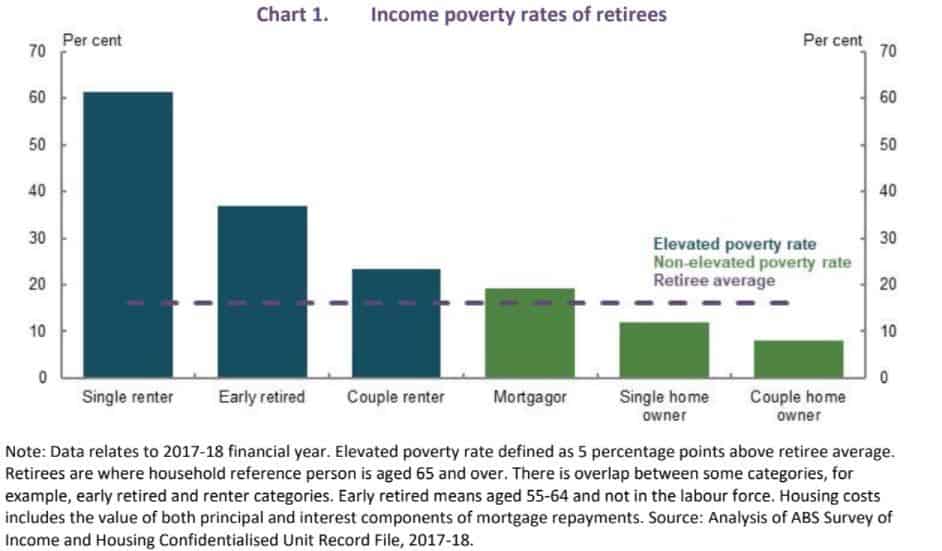The Retirement Income Review was released by the Australian government in July 2020. The report provides an overview of Australia’s current retirement income system, taking into account Australia’s ageing population and society. The objective of the Retirement Income Review is to improve the understanding of the operations and outcomes of the system designed to support retired Australians. Dr Deborah Ralston, chair of Household Capital’s advisory board, was one of three panelists who worked on and authored the Retirement Income Review 2020. The report revealed the system to be effective, but noted room for improved outcomes for retirees. Detailed below is a summary of statistics and outcomes cited from the ‘Retirement Income Review, Final Report, July 2020’
Financial Stress
- Most households in retirement are not in financial stress and are not living in poverty (Chart 1). The main exceptions are a number of retirees on the Age Pension who rent in the private market and those who retire before Age Pension eligibility age, particularly those who retire involuntarily.
- Twenty-eight percent of early retirees are in financial stress. Renters who retire before Age Pension eligibility age have the highest level of financial stress in retirement.
Retirement income by Gender
- The gap in retirement savings and retirement incomes for women is the accumulated result of the economic disadvantages faced by women in their working life — lower wages than men, more career breaks for child-rearing and caring for others, and more part-time work. The financial impacts from divorce and relationship breakdowns are also worse for women.
- Across men and women who work full-time, the pay gap is 17 percent. More than 93 percent of all primary carer leave is taken by women. Research suggests having children is associated with a reduction in earnings of up to 80 percent on average over the following 15 years, compared to women with no children.
- The retirement income system does not appear to be delivering an appropriate standard of living for many retiree renters.
The Pension
- As at June 2019, around 71 percent of people aged 65 and over received Age Pension or other pension payments.Over 60 percent of these were on the maximum rate.
- The Age Pension is more than a safety net that supports those who do not have the means to achieve a minimum standard of living in retirement. It supplements the income for about 65 percent of Australians in retirement.
- The changes to the Age Pension in 2009 led to a large reduction in rates of income poverty.
- Lower-income earners (defined as bottom 30 percent of all income earners) primarily rely on the Age Pension to support their standard of living in retirement.
- Middle-income earners require a combination of superannuation, voluntary savings and the Age Pension to maintain their living standards in retirement.
- Higher-income earners (top 20 percent of all earners) generally do not receive the Age Pension and rely on the SG, voluntary superannuation, along with other savings and their home to maintain their living standards in retirement.
- In terms of price movements, the Age Pension has increased by 32 percent since 2010, while the CPI has increased by 20 percent.
- On international comparisons, the Age Pension is equal to 27.8 percent of gross earnings, placing Australia eighth out of 36 OECD countries.
Superannuation
- For most households aged 65 and over, the family home is their main asset. Superannuation makes up a small share of their net wealth. This will change as the superannuation system matures.
- Australia’s superannuation arrangements are still maturing, although to date they have resulted in around 16 million Australians collectively owning close to $3 trillion in assets.
- The SG was introduced in 1992. Initially set at 3 percent of an employee’s ordinary time earnings, it has since gradually increased to 9.5 percent today and is legislated to gradually reach 12 percent on 1 July 2025.
- Many very large superannuation balances were built up under previous higher contributions caps and are expected to stay in the system for several decades. At June 2018, there were more than 11,000 people with a balance in excess of $5 million. These people receive very large tax concessions on their earnings. A superannuation balance of $5 million can achieve annual earnings tax concessions of around $70,000.
- Voluntary (pre- and post-tax) superannuation contributions are predominantly made by older, higher-income or wealthy people. Average pre-tax voluntary contributions increase with age and peak just before 65. Average post-tax voluntary contributions are much higher for people aged between 60-64 compared with younger people.
Home Equity
- Few retirees use the equity in their home to support their standard of living in retirement. The options available to do so include reverse mortgages, equity release schemes, home equity loans and downsizing. Reverse mortgages are the main product available, but usage is low.
- For most retirees, the family home is their main asset. Using relatively small portions of home equity can substantially improve retirement incomes.
- Releasing home equity can boost retirement incomes with a modest impact on debt. Withdrawing $5,000 a year would mean that retirees still have about three-quarters of the value of their home at age 92, for a house worth $500,000 at retirement. Retirees with higher value homes would maintain even higher proportions of home equity while still benefiting from significant improvements in replacement rates.
- Creating additional home equity that can be accessed to boost income in retirement. Accessing home equity can help offset the impact on people’s liquid assets from using superannuation to pay off a mortgage.







